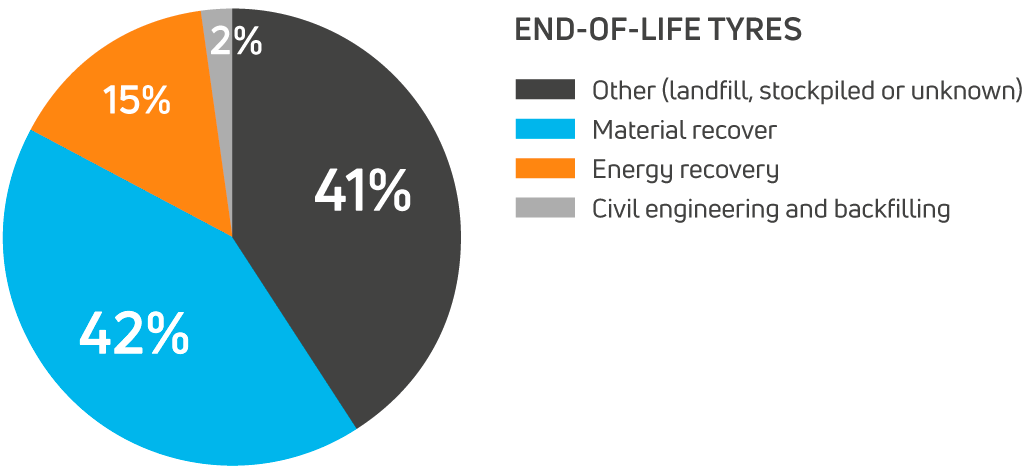In this article, we take a closer look at tyre waste – one of the many downsides of rubber tyres.

Every year millions of tyres across the European continent are being left out in the open or end up in huge landfills in developing countries. The EU outlawed the practice of dumping tyres into landfills as early as 2003, due to its environmental concerns and potential leakage of dangerous chemicals.

Since then, a growing market for the shipment of used tyres has been established. This article will look more closely at this controversial practice and illuminate why this is problematic and does serious harm to both the environment and people.
Different reports will provide varying estimates on the number of tyres that are being shipped overseas and that do not end up in the European system for end of life processing. However, itis widely believed that at least 1 billion tyres are discarded every year.
In reality these are most likely conservative figures as leading research has collected data showing that 1.8 billion tyres reach end of life every year, creating a formidable environmental challenge.
As of present, an estimated 4 billion tyres are sitting around in landfills globally, a number set to increase dramatically given the large number of tyres that reach end of life every year. Some sources estimate that as many as 41% of all tyres that have reached end of life will end up in different landfills, stockpiled or even have an unknown future.
It is widely understood that tyres left in the open or exposed to the elements are having a detrimental impact on local habitats, through rubber leakage and the spread of microplastics due to corrosion, something that was instrumental in creating the ban on dumping tyres into landfills.
Secondly, a rubber fire in a landfill or at any other site with multiple tyres is a major safety risk. In Heyope, Wales a fire in a landfill containing an estimated 10 million tyres lasted from 1989 to 2004 before it dissipated.
Similar incidents have taken place in several other locations as well – such as with the 2021 fire in Jahra, Kuwait that was visible from space and required massive resources to extinguish. This enormous landfill was estimated to contain almost 50 million tyres and have seen multiple fires erupt over the years.

Outsourcing the problem
The EU outlawed the practice of dumping tyres into landfills already back in 2003, citing environmental concerns due to the potential leakage of dangerous chemicals.
But due to the increased demand for tyres globally, a disproportionate number of tyres are still shipped off to developing countries, where large quantities end up in landfills. More on the ethical and security issues this presents later.
Several countries on the African and Asian continent have become important entry points and “hubs” for discarded rubber tyres, disposal and pyrolysis processes with the aim of turning tyres into fuel or recovering the carbon black.
Moreover, a huge number of tyres do not end up being processed or turned into fuel, instead they end up in those same landfills described above. From Kuwait to India, these landfills are a massive environmental hazard and twenty years after the EU outlawed tyre landfills in the EU, European companies are contributing to the same problem abroad.
This growing market for tyre exports between countries in Europe and poorer, developing countries is problematic on multiple fronts. It contributes to worsened air pollution and local emissions through a lack of proper storage and end of life treatment. The tyres are often dumped by the wayside or in enormous landfills, alternatively they are being set on fire, releasing dangerous chemicals.

Secondly, the act of reusing old and worn out tyres represents a big ethical issue in terms of safety, as it could also lead to traffic accidents if the tyres have not been retreaded or handled properly.
In conclusion, the practice of western countries exporting old tyres to developing nations only shifts the environmental burden rather than genuinely addressing it. By merely relocating the problem, we fail to grapple with the core issue. A truly sustainable, global perspective recognizes that our planet is an interconnected ecosystem; outsourcing our problems doesn’t make them disappear.
Sources and more information
What Happens When Tires Reach The End Of The Road? via forbes.com
End-of-life options of tyres. A review via sciencedirect.com
Treatment and disposal of tyres. Two EU approaches. A review via sciencedirect.com
A management system for end-of-life tyres… via sciencedirect.com
Circular Economy: Retreading – a win-win situation via etrma.org
So very, very tyred via renew.org
Kuwaiti citizens deal with effects of fires in world’s largest tyre graveyard via observers.france24.com
Our Waste Tire Problem Is Getting Worse via popularmechanics.com
Britain’s dirty secret: the burning tyres choking India via theguardian.com


